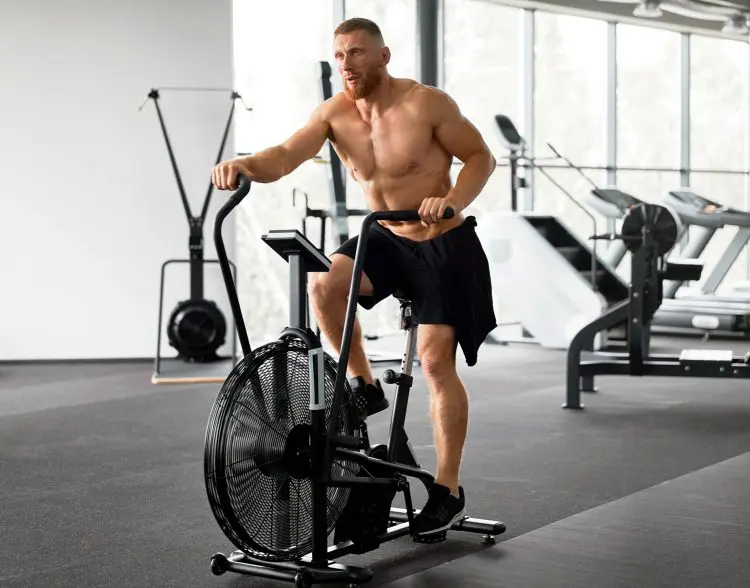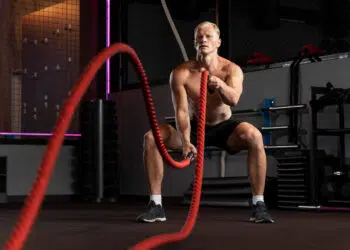Go to any gym, and you’ll see lots of exercisers plodding away on treadmills and ellipticals in pursuit of their fitness and weight loss goals. This is entirely understandable as the health and fitness industry has long put steady-state cardio on a pedestal, considering it the cornerstone of any good workout program.
While there is no denying the many proven benefits of steady-state cardio (1), there are drawbacks to this type of training. For example, cardio can be time-consuming and boring, and while it’s good for your general fitness and health, it won’t do much for the condition of your muscles.
As a veteran personal trainer, I know that your time and energy are precious, and the last thing I want you to do is waste them on unproductive, one-dimensional workouts. That’s why I insist that all my clients put as much effort into compound lifting as they do cardio.
This often comes as a shock to new exercisers, but they quickly learn how powerful compound lifting can be. The incredible results speak for themselves.
In this article, I discuss the many benefits of compound lifting over steady-state cardio and provide three beginner-friendly lifting routines to try.
What Is Compound Lifting, Anyway?

Before I reveal the benefits of compound lifting, let me explain what this type of training is all about.
Level Up Your Fitness: Join our 💪 strong community in Fitness Volt Newsletter. Get daily inspiration, expert-backed workouts, nutrition tips, the latest in strength sports, and the support you need to reach your goals. Subscribe for free!
Broadly speaking, strength exercises can be categorized as either isolation or compound. Isolation exercises involve movement around one joint, typically targeting very few muscles. Popular isolation exercises include calf raises, leg extensions, lateral raises, and triceps kickbacks.
In contrast, compound exercises involve two or more joints and multiple muscles. Examples of compound lifts include squats, deadlifts, push-ups, pull-ups, and lunges.
While there is nothing inherently wrong with isolation exercises, compound lifts provide more bang for your buck, delivering superior benefits in less training time. As such, they should be the cornerstone of any well-designed strength training program.
Learn more about compound vs. isolation exercises in this compelling article.
Benefits of Compound Lifting
I believe cardio is more popular than strength training because the benefits are not so well known. After all, almost everyone knows that cardio is good for your heart and lowers your risk of many serious diseases (1). The Centers for Disease Control (CDC) even recommends that most adults need to do 150 minutes per week to be fit and healthy (2).
However, there is no such equivalent recommendation for strength training.
It’s time to put the record straight and reveal the many benefits of strength training. After reading this list, I believe you’ll see the value of lifting weights and be only too happy to incorporate compound lifting into your workouts.
Fat Loss and Weight Control
Cardio is not the only (or even the best) way to burn fat and control your weight. In fact, research suggests that compound lifting can be just as effective, and sometimes even more so (3). Like cardio, lifting weights burns kilocalories, which, combined with an appropriate diet, will contribute to your energy deficit, forcing your body to burn fat for fuel.
Use this calculator to see how many kilocalories you can burn by lifting weights.
Improved Metabolism
Regular strength training is linked to improved metabolic health, which is how your body breaks down and utilizes food and energy (3). A healthy metabolism enhances your ability to burn fat and lose weight, making weight and fat gain less likely.
Compound strength training enhances many metabolic functions, including:
- Increased Basal Metabolic Rate (BMR) and Total Daily Energy Expenditure (TDEE)
- Improved insulin sensitivity and glucose tolerance
- Better nutrient partitioning
- Better lipid (fat) metabolism
- Increased mitochondrial density
- Improved hormone regulation
Muscle Preservation
Muscles get weaker and smaller with lack of use, and this decline accelerates as you age. This explains why older people are sometimes too weak to live independently. Low-kilocalorie diets also hasten muscle loss.
While some age-related muscle loss is inevitable and can be part and parcel of strict dieting, compound strength training helps slow this decline and may even reverse it. Preventing muscle loss will enhance functional strength, preserving your ability to perform the physical activities of daily living (4).
Increased Bone Density
It’s not just muscles that weaken with age and lack of use; bones do, too. This is called osteopenia, which, without intervention, can become osteoporosis, a condition characterized by porous, fragile bones.
Compound lifting stimulates bone-building cells called osteoblasts. Consequently, strength training is an effective way to preserve or improve bone density (5).
Level Up Your Fitness: Join our 💪 strong community in Fitness Volt Newsletter. Get daily inspiration, expert-backed workouts, nutrition tips, the latest in strength sports, and the support you need to reach your goals. Subscribe for free!
Improved Cardiovascular Fitness and Health
Contrary to what many people think, cardio is not the only way to enhance heart, lung, and circulatory health. Lifting weights can help lower your risk of heart disease, control blood pressure, and boost circulation (6). Compound lifts are also sufficiently demanding to improve cardiovascular fitness.
Of course, if you want to be a better runner, cyclist, or swimmer, those are the activities you must emphasize in your training. But, if you need general cardiovascular fitness, lifting weights will help.
In summary, strength training is good for many aspects of your health and can help you burn fat and control your weight. As such, no matter your age, gender, or experience level, compound lifting deserves a place in your workout schedule.
The Drawbacks of Steady-State Cardio
It’s not my intention to stop anyone from doing cardio. However, I think it’s important to understand that it has some drawbacks, especially if it’s the only type of workout you do.
These drawbacks include:
Fewer Muscular System Benefits
While no one can deny the heart, lung, and circulatory benefits of cardio, jogging, swimming, cycling, etc., have a much smaller impact on your muscular system. Cardio doesn’t build muscle and won’t make you stronger. However, it does improve muscular endurance.
In contrast, compound lifting is very good for muscular health and offers numerous cardiovascular benefits.
Time-Consuming
According to the CDC, most adults should do 150 minutes of cardio per week. This is a significant chunk of time – the equivalent of 30 minutes six days a week.
In contrast, just a few minutes of compound lifting can provide comparable benefits. Research on PubMed suggests that as little as 15-30 minutes of strength training per week can be effective for developing basic strength and health benefits (7).
Possible Boredom
Some people find repetitive workouts like running, biking, and rowing boring. Boredom and lack of enjoyment are common barriers to exercise adherence. Sure, you can do more varied cardio workouts such as group exercise classes or circuit training. However, most people associate cardio with steady-state workouts.
Are you sold on the benefits of compound lifting for fitness and fat loss? Then check out the next section, where you’ll find three tried-and-tested beginner-friendly routines to get you started.
3 Beginner-Friendly Compound Lifting Routines
Are you looking for a full-body compound lifting program to try? I’ve got you covered! Here are three proven routines designed specifically for beginners. Pick one or do them in rotation. Train 2-3 times a week on non-consecutive days for best results, e.g., Monday, Wednesday, and Friday.
However, before you begin, always prepare your muscles and joints for what you are about to do with a short warm-up. 5-10 minutes of light cardio followed by dynamic mobility and flexibility exercises for your major joints and muscles should be sufficient.
Related: How to Warm Up for Strength Training
Machines Only
Resistance machines are an excellent option for beginners. Your movements are guided, so you don’t have to worry about learning tricky techniques or balancing weights. They’re also generally safer for solo exercisers as there are no barbells or dumbbells to drop.
| Exercise | Sets | Reps | Recovery | |
| 1 | Leg press | 2-4 | 8-15 | 60-90 secs |
| 2 | Chest press | 2-4 | 8-15 | 60-90 secs |
| 3 | Lat pulldown | 2-4 | 8-15 | 60-90 secs |
| 4 | Cable pull-through | 2-4 | 8-15 | 60-90 secs |
| 5 | Shoulder press | 2-4 | 8-15 | 60-90 secs |
| 6 | Seated row | 2-4 | 8-15 | 60-90 secs |
| 7 | Cable standing crunch | 2-4 | 8-15 | 60-90 secs |
Freeweights and Machines
Freeweight exercises develop balance and coordination. As such, they’re good for your nervous system as well as your muscles. This workout combines classic barbell and dumbbell exercises with a few staple machines to deliver a fun and effective full-body workout.
| Exercise | Sets | Reps | Recovery | |
| 1 | Barbell squat | 2-4 | 8-15 | 60-90 secs |
| 2 | Dumbbell bench press | 2-4 | 8-15 | 60-90 secs |
| 3 | Lever row machine | 2-4 | 8-15 | 60-90 secs |
| 4 | Smith machine good morning | 2-4 | 8-15 | 60-90 secs |
| 5 | Barbell shoulder press | 2-4 | 8-15 | 60-90 secs |
| 6 | Assisted close-grip chin-up | 2-4 | 8-15 | 60-90 secs |
| 7 | Cable Pallof press | 2-4 | 8-15 | 60-90 secs |
Freeweights Only
Freeweights let you customize your exercises by adjusting your hand or foot width or the position of your body. In contrast, most machines are built to fit average people, so they’re not suitable for everyone. Freeweights are also more accessible for most home exercisers.
| Exercise | Sets | Reps | Recovery | |
| 1 | Front squat | 2-4 | 8-15 | 60-90 secs |
| 2 | Incline barbell bench press | 2-4 | 8-15 | 60-90 secs |
| 3 | Bent-over dumbbell row | 2-4 | 8-15 | 60-90 secs |
| 4 | Barbell hip thrust | 2-4 | 8-15 | 60-90 secs |
| 5 | Dumbbell shoulder press | 2-4 | 8-15 | 60-90 secs |
| 6 | Single-arm dumbbell row | 2-4 | 8-15 | 60-90 secs |
| 7 | Barbell rollout | 2-4 | 8-15 | 60-90 secs |
Conclusion
There is a strong argument for saying that cardio is the most critical type of exercise. After all, it directly affects your cardiorespiratory system, which keeps you alive by pumping oxygenated blood around your body.
However, compound lifting is equally important. It provides many of the benefits of cardio plus several notable additions, including improved functional strength, bone mass, and metabolism.
Most well-balanced health and fitness programs should include cardio and strength training. But, if you HAVE to choose between these two workouts, e.g., because you are short of time, compound lifting is probably the workout you should pick.
It offers a wider range of benefits than cardio, and workouts can be shorter and less frequent. In simple terms, compound strength training provides the best return on your time investment.
References:
- Steele J, Plotkin D, Van Every D, Rosa A, Zambrano H, Mendelovits B, Carrasquillo-Mercado M, Grgic J, Schoenfeld BJ. Slow and Steady, or Hard and Fast? A Systematic Review and Meta-Analysis of Studies Comparing Body Composition Changes between Interval Training and Moderate Intensity Continuous Training. Sports (Basel). 2021 Nov 18;9(11):155. doi: 10.3390/sports9110155. PMID: 34822354; PMCID: PMC8619923.
- Centers for Disease Control: Physical Activity for a Healthy Weight.
- Wewege MA, Desai I, Honey C, Coorie B, Jones MD, Clifford BK, Leake HB, Hagstrom AD. The Effect of Resistance Training in Healthy Adults on Body Fat Percentage, Fat Mass and Visceral Fat: A Systematic Review and Meta-Analysis. Sports Med. 2022 Feb;52(2):287-300. doi: 10.1007/s40279-021-01562-2. Epub 2021 Sep 18. PMID: 34536199.
- Miller T, Mull S, Aragon AA, Krieger J, Schoenfeld BJ. Resistance Training Combined With Diet Decreases Body Fat While Preserving Lean Mass Independent of Resting Metabolic Rate: A Randomized Trial. Int J Sport Nutr Exerc Metab. 2018 Jan 1;28(1):46-54. doi: 10.1123/ijsnem.2017-0221. Epub 2018 Jan 24. PMID: 28871849.
- Maestroni L, Read P, Bishop C, Papadopoulos K, Suchomel TJ, Comfort P, Turner A. The Benefits of Strength Training on Musculoskeletal System Health: Practical Applications for Interdisciplinary Care. Sports Med. 2020 Aug;50(8):1431-1450. doi: 10.1007/s40279-020-01309-5. PMID: 32564299.
- Liu Y, Lee DC, Li Y, Zhu W, Zhang R, Sui X, Lavie CJ, Blair SN. Associations of Resistance Exercise with Cardiovascular Disease Morbidity and Mortality. Med Sci Sports Exerc. 2019 Mar;51(3):499-508. doi: 10.1249/MSS.0000000000001822. PMID: 30376511; PMCID: PMC7385554.
- Sundell J. Resistance Training Is an Effective Tool against Metabolic and Frailty Syndromes. Adv Prev Med. 2011;2011:984683. doi: 10.4061/2011/984683. Epub 2010 Dec 13. PMID: 21991450; PMCID: PMC3168930.










